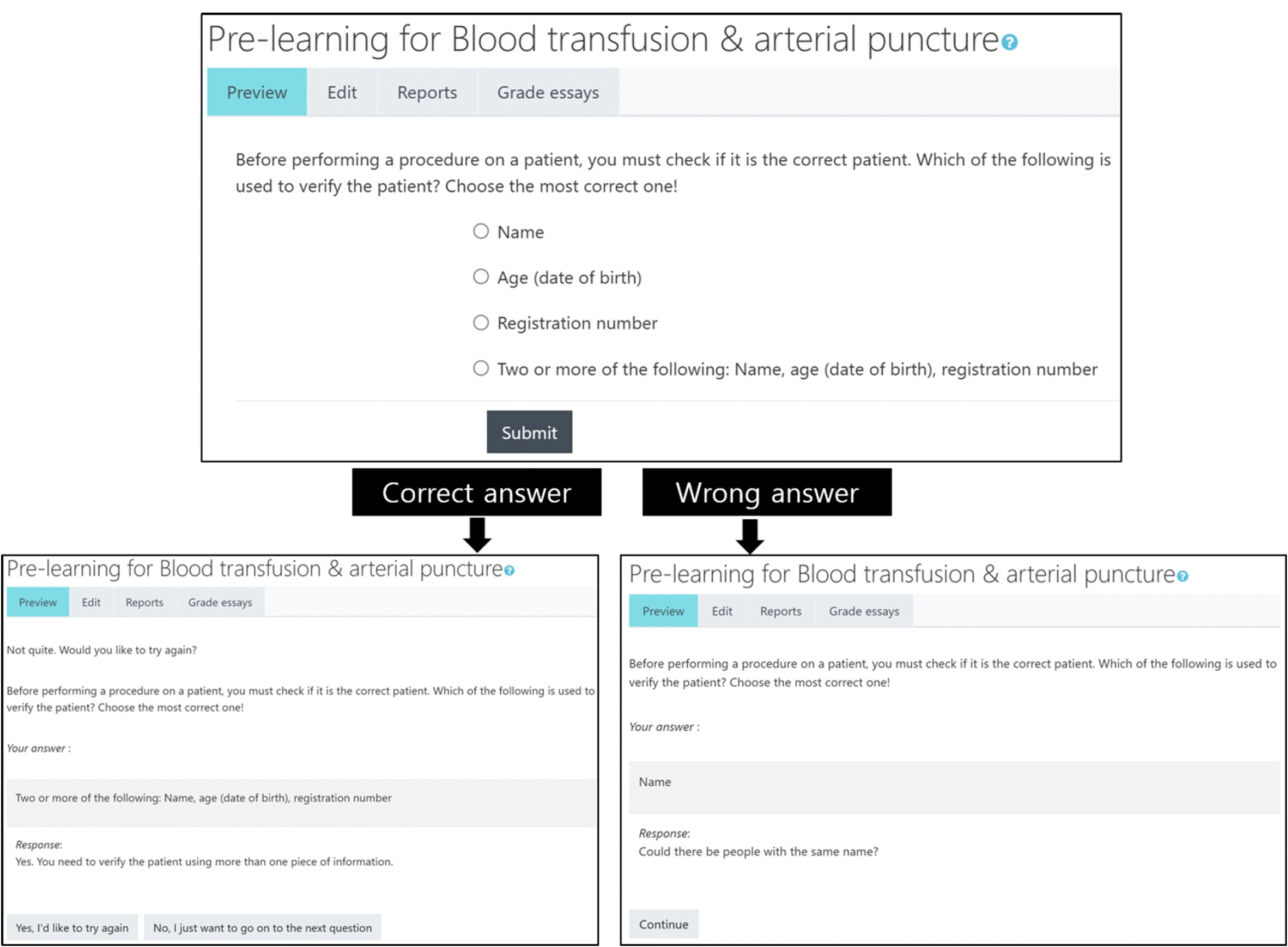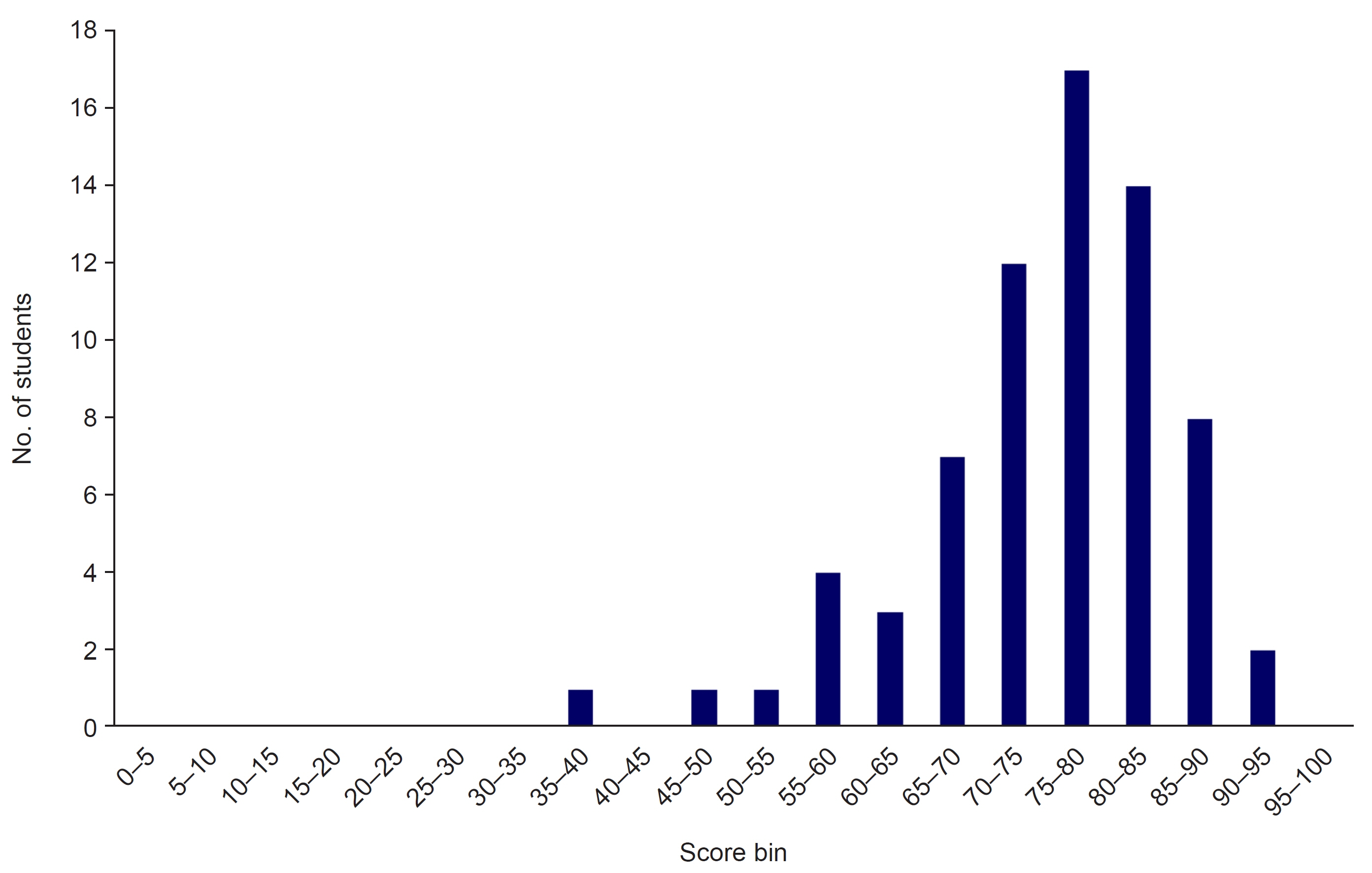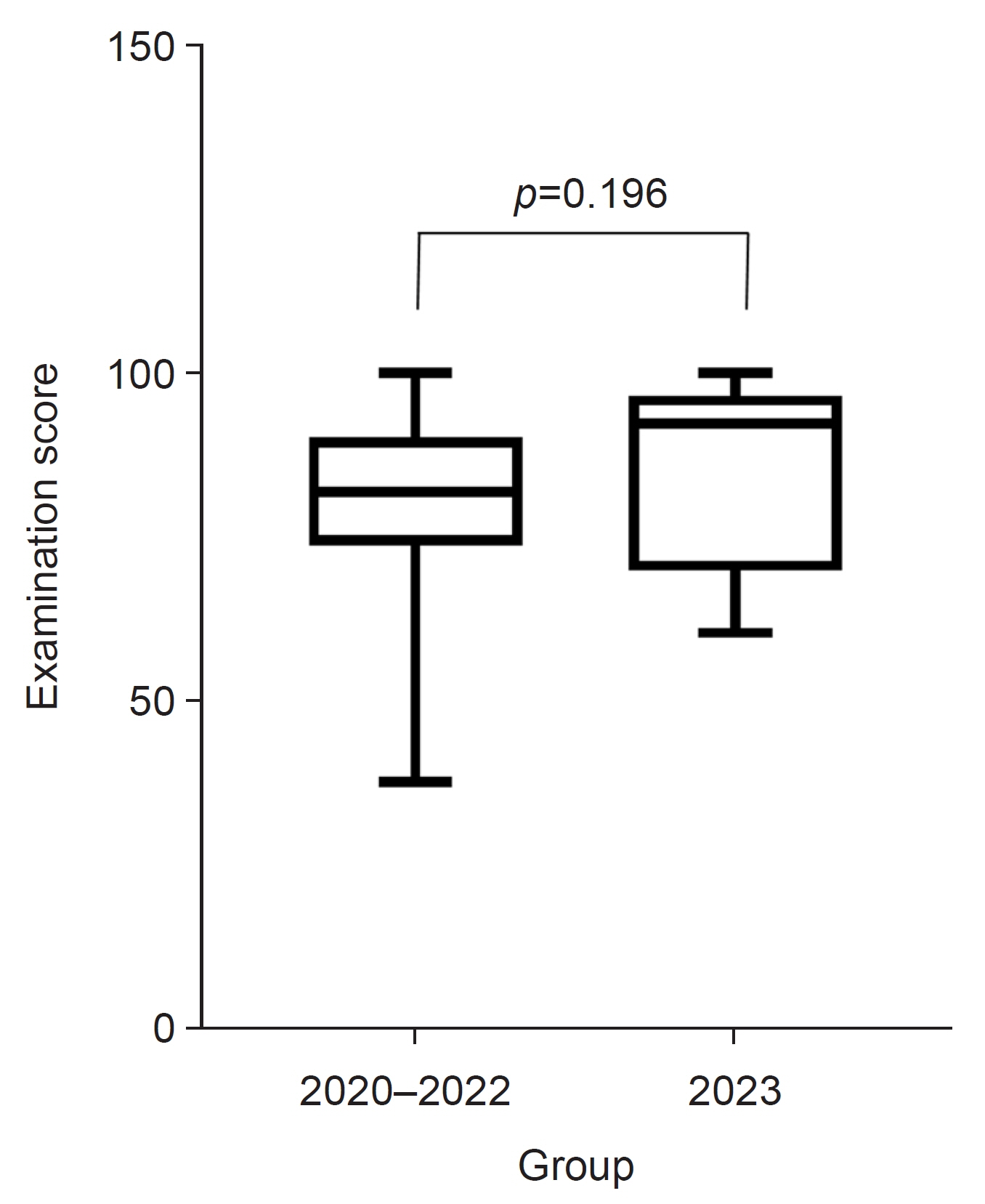Kosin Med J.
2023 Dec;38(4):278-287. 10.7180/kmj.23.150.
The effectiveness of Moodle's “Lesson” feature in pre-learning about arterial puncture and blood transfusion procedures
- KMID: 2549501
- DOI: http://doi.org/10.7180/kmj.23.150
Abstract
- Background
This study evaluated the effectiveness of Moodle’s “Lesson” feature as a pre-learning tool for clinical skills among medical students.
Methods
The performance of 69 fourth-year medical students during practical sessions on arterial puncture and blood transfusion was assessed. These students engaged in pre-learning activities via Moodle's “Lesson” feature. We analyzed the survey results to gauge students’ satisfaction and perceived usefulness of the pre-learning approach. Additionally, we compared the performance of the 2023 cohort, which took part in the pre-learning process, with students from 2020 to 2022 who did not have this preparatory component.
Results
Among the students surveyed, data from 59 respondents were analyzed. Satisfaction with the pre-learning segment was high, with a mean satisfaction score of 4.69 (standard deviation [SD]=0.62) and Cronbach’s alpha of 0.918. The tool's perceived usefulness was also rated highly, with a mean score of 4.77 (SD=0.53) and Cronbach’s alpha of 0.956. Students who used the pre-learning tool had a mean score of 84.20 (SD=14.74), whereas those who did not use the tool scored slightly lower, with a mean of 80.40 (SD=13.07); however, this difference was not statistically significant (p=0.196). Nonetheless, the 2023 cohort scores were generally higher across the various percentile measures than those of the 2020–2022 groups.
Conclusions
The pre-learning tool using the “Lesson” feature on Moodle proved useful and satisfactory for students learning clinical procedures. Further research with larger cohorts is required to validate these findings.
Figure
Reference
-
References
1. Buscombe C. Using Gagne's theory to teach procedural skills. Clin Teach. 2013; 10:302–7.2. Khadjooi K, Rostami K, Ishaq S. How to use Gagne's model of instructional design in teaching psychomotor skills. Gastroenterol Hepatol Bed Bench. 2011; 4:116–9.3. Liu TC, Lin YC, Paas F. Effects of prior knowledge on learning from different compositions of representations in a mobile learning environment. Computers & Education. 2014; 72:328–38.4. Van Gog T, Paas F, Sweller J. Cognitive load theory: advances in research on worked examples, animations, and cognitive load measurement. Educ Psychol Rev. 2010; 22:375–8.5. Robinson JD, Persky AM. Developing self-directed learners. Am J Pharm Educ. 2020; 84:847512.6. Oh CE, Hwang H. How does quiz activity affect summative assessment outcomes? An analysis of three consecutive years’ data on self-directed learning. Kosin Med J. 2022; 37:228–35.7. Jeong S, Hwang H. Do we need Moodle in medical education? A review of its impact and utility. Kosin Med J. 2023; 38:159–68.8. Hwang H. A computer-assisted, real-time feedback system for medical students as a tool for web-based learning. Kosin Med J. 2016; 31:134–45.9. Lee SS, Lee H, Hwang H. New approach to learning medical procedures using a smartphone and the Moodle platform to facilitate assessments and written feedback. Kosin Med J. 2022; 37:75–82.10. Jamieson S. Likert scales: how to (ab)use them. Med Educ. 2004; 38:1217–8.11. Kee YH. Reflections on athletes’ mindfulness skills development: Fitts and Posner’s (1967) three stages of learning. J Sport Psychol Action. 2019; 10:214–9.12. Tenison C, Anderson JR. Modeling the distinct phases of skill acquisition. J Exp Psychol Learn Mem Cogn. 2016; 42:749–67.13. Narayan R, Rodriguez C, Araujo J, Shaqlaih A, Moss G. Constructivism-constructivist learning theory. In: Irby BJ, Brown G, Lara-Alecio R, Jackson S, editors. The handbook of educational theories. IAP Information Age Publishing; 2013. p. 169-83.14. Margolis JF, Christina RW. A test of Schmidt's schema theory of discrete motor skill learning. Res Q Exerc Sport. 1981; 52:474–83.15. Sherwood DE, Lee TD. Schema theory: critical review and implications for the role of cognition in a new theory of motor learning. Res Q Exerc Sport. 2003; 74:376–82.16. Permana R, Sabirin F, Feladi V. Effect of self efficacy and prior knowledge on students’ skills. J Educ Teach Learn. 2016; 1:76–81.17. Cordova JR, Sinatra GM, Jones SH, Taasoobshirazi G, Lombardi D. Confidence in prior knowledge, self-efficacy, interest and prior knowledge: influences on conceptual change. Contemp Educ Psychol. 2014; 39:164–74.18. Zhou Z, Wang S, Qian Y. Learning from errors: exploring the effectiveness of enhanced error messages in learning to program. Front Psychol. 2021; 12:768962.19. Kiesewetter J, Sailer M, Jung VM, Schonberger R, Bauer E, Zottmann JM, et al. Learning clinical reasoning: how virtual patient case format and prior knowledge interact. BMC Med Educ. 2020; 20:73.20. Lu SY, Ren XP, Xu H, Han D. Improving self-directed learning ability of medical students using the blended teaching method: a quasi-experimental study. BMC Med Educ. 2023; 23:616.21. Patra S, Khan AM, Upadhyay MK, Sharma R, Rajoura OP, Bhasin SK, et al. Module to facilitate self-directed learning among medical undergraduates: development and implementation. J Educ Health Promot. 2020; 9:231.22. Singaram VS, Naidoo KL, Singh S. Self-directed learning during the COVID-19 pandemic: perspectives of South African final-year health professions students. Adv Med Educ Pract. 2022; 13:1–10.23. Nowell L, Dhingra S, Carless-Kane S, McGuinness C, Paolucci A, Jacobsen M, et al. A systematic review of online education initiatives to develop students remote caring skills and practices. Med Educ Online. 2022; 27:2088049.24. Kyaw BM, Posadzki P, Paddock S, Car J, Campbell J, Tudor Car L. Effectiveness of digital education on communication skills among medical students: systematic review and meta-analysis by the digital health education collaboration. J Med Internet Res. 2019; 21:e12967.25. Kc D. Evaluation of Moodle features at Kajaani University of Applied Sciences: case study. Procedia Comput Sci. 2017; 116:121–8.26. Bower M, Wittmann M. A comparison of lams and Moodle as learning design technologies: teacher education students’ perspective. Teach English Technol. 2011; 11:62–80.27. Habrusiev V, Tereshchuk H, Panchenko V, Martyniuk S, Sysoiev O, Henseruk H. Enhancing online learning in LCM Moodle through interactive adaptive learning. In: 2023 13th International Conference on Advanced Computer Information Technologies (ACIT); 2023 Sep 21-23; Wroclaw, Poland. IEEE; 2023. p. 650-5.28. Kurniawan B, Rahmawati I, Fawaiz S. E-module implementation by using feature-lesson-based of Moodle in physics learning multimedia practices for students of prospective physics teacher. J Pendidikan Fisika Indones. 2023; 19:76–88.
- Full Text Links
- Actions
-
Cited
- CITED
-
- Close
- Share
- Similar articles
-
- Do we need Moodle in medical education? A review of its impact and utility
- New approach to learning medical procedures using a smartphone and the Moodle platform to facilitate assessments and written feedback
- Advances in Pre-transfusion Testing and Immunohematology
- The development of a learning management system for dental radiology education: A technical report
- Effects on Problem Solving Ability and Learning Satisfaction of Nursing Students of Receiving a Teaching Method Using Standardized Patients - Blood Transfusion




